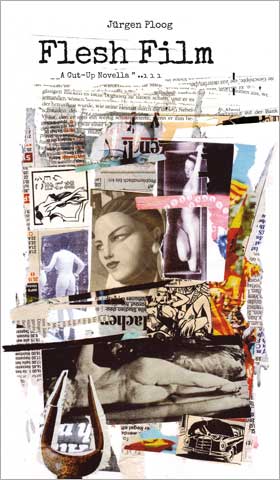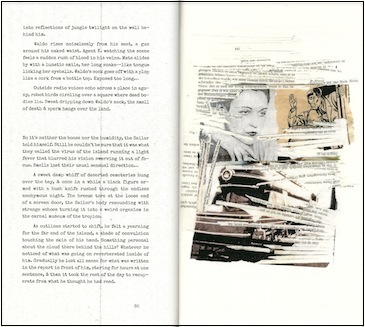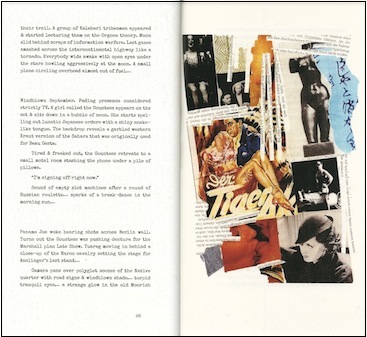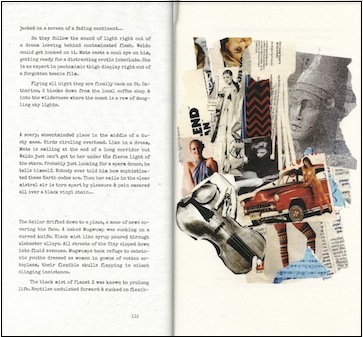It is a rare thing when a book comes along that looks as magnificent as Flesh Film and reads like an hallucination. To be clear, Jürgen Ploog is an author who does not write for everyone. The “story” he tells in Flesh Film has the pulpy tone of science fiction, a narrator who sounds like a globe-trotting private eye down on his luck, and a title that signals the author’s take on reality as a metaphysical construct.
The story is in fact nothing more — or less — than a collage of words written in Ploog’s customary cut-prose style, derived from the Burroughs-Gysin cut-up technique. And although the tale has the coloration of a Burroughsian world, its atmosphere is unique to Ploog’s experience as a former Lufthansa space jockey. He used to pilot 747s across the world — it did something strange to his sensibility besides giving him a bird’s eye view.
As designed by Robert Schalinski for the German publisher Moloko Print, the text of Flesh Film looks like a manuscript duplicated on an old copying machine. Meanwhile, the visual collages (also “written” by Ploog as a series of hieroglyphic fantasies) lend a splendid sort of punctuation to this fever dream. Something else worth noting: Although Ploog’s native language is German, Flesh Film was written directly in English. When it comes to cut-prose, he says, “it’s easier that way.”
Here are some excerpts for your viewing and reading pleasure.
+++++
Click the images and/or the captions to enlarge and read.
He remembers endless night flights when the body of a pilot is transformed into an artifact of silent language. Spoken words can single out patches of time but they cannot stop the tidal flow of space, the ultimate traveler being stranded between islands of matter. On deck a woman is leaning at the rail. Her scarf flutters in the wind. Is she real or just a reflection of the misty sea? He asks her if she is alone. No, crewmembers are watching them. For a long time they stand side by side, neither saying a word. Sometimes he hears her voice, which is but a whisper in the wind. What’s she saying?
+++++
Waldo rises noiselessly from his seat, a gun around his naked waist. Agent K. watching the scene feels a sudden rush of blood in his veins. Mata slides by with a lunatic smile, her long snake-like tongue licking her eyeballs. Waldo’s cock goes off with a plop like a cork from a bottle top.
Exposed too long. Outside radio voices echo across a place in agony, robot birds circling over a square where dead bodies lie. Sweat dripping down Waldo’s neck, the smell of death & sperm hangs over the land. …
+++++
+++++
Windblown September. Fading presence considered strictly TV. A girl called Countess appears on the set & sits down in a bubble of neon. She starts spelling out lunatic Japanese orders with a shiny snakelike tongue. The backdrop reveals a garbled western Kraut version of the Sahahra that was originally used for Beau Geste.
“I’m signing off right now.”
+++++
Tired & freaked out, the Countess retreats to a small motel room stashing the phone under a pile of pillows.
A scary, absent-minded place in the middle of dusty mesa. Birds circling overhead. Like in a dream, Mata is smiling at the end of a long corridor but Waldo just can’t get to her under the fierce light of the stars. Probably just looking for a sperm donor, he tells himself. Nobody ever told him how sophisticated these Earth codes are. Then her smile in the clear mistral air is torn apart by pleasure & pain smeared all over a black vinyl chair …
Sound of empty slot machines after a round of Russian roulette … sparks of a break-dance in the morning sun …
+++++






In this modern media world, is it not natural that we think of reality as a “metaphysical construct?” As Baudrillard notes, the world that the media creates is a simulacrum. The Second Iraq War, for example, was based on justifications about WMDs that were entirely constructed — consciously devoid of actual reality. Here in Europe, outside of the US media bubble, this was apparent to everyone. The whole world got to watch the American political and media machine (it’s all one thing) create absurd vulgarities to justify a war and its consequences that would create at least a million deaths. And the people who led this were perverts straight from the pages of Burroughs, and Bukowski, Cheney, Rumsfeld, George Pearl, Paul Wolfowitz, Elliott Abrams, Norman Podhoretz, et al.
The imagery of our media is also the paradigm of the collage and cutup. Reality is chopped into a million bits and reassembled to create a metaphysical reality suited, as it were, to the perverts who lead and formulate our “Democracy.” And even better, the collages are not just two dimensional, but have multi-dimensional layers determined by which “realities” go on page one and which uncomfortable realities go in the back pages. This imagery and literature is amplified with headlines and lead paragraphs, a metaphysical soundbite language mastered by the Grab’em by the Pussy Pervert. All consumers of American media should be familiar with Burroughs so that they can fully understand and appreciate the ingenious literature they are experiencing.
Occasionally a fly gets in this ointment, like the way Knight-Ridder never bought the arguments of the Princes of Darkness about WMDs in Iraq. Knight-Ridder was left out of the simulacrum probably because, among its 30 or so newspapers, there are none in Washington or New York City, the beating heart of the simulacrum’s metaphysical reality. But that’s not a problem: dissent becomes part of the collage too, “the little pricks of reality” that cause static on the video screen of our metaphysical simulacrums.
There’s a film called “Shock and Awe” that portrays the struggle of Knight-Ridder in its role as the little pricks of reality standing up against the NYT, WP, WJS, ABC, NBC, CNN, CBS, et al during the buildup to the Iraq War. It’s pretty good. Check it out.
In the meantime, I read daily about Trump—-in papers identified by Burroughs and Co. during the 20th century as the other whores of genocide–and see it as a love child of Boris Lurie’s No!art.
Sorry for this strange comment, but I think of Winne in Beckett’s “Happy Days” who asks: “Strange? No, everything here is strange.”
Jan,
Thank you for the wonderful news about Jürgen’s FLESH FILM!
For some years, I’ve treasured the material posted at the Reality Studio, and to now learn the text has made it all the way to a published book with awesome collages delights me.
Your work, and that of Jürgen’s and Carl’s are gifts that never stop giving.
Bravo Jürgen!